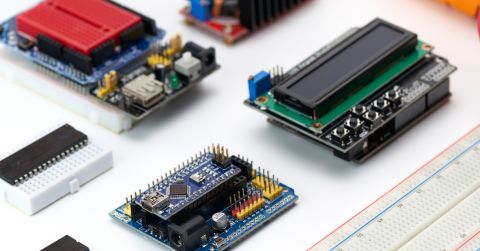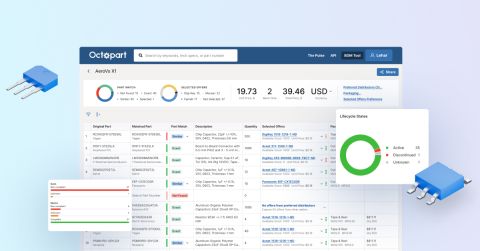TVS Diodes Rated to IEC 61000-4-2 for ESD Protection

Transient voltage suppressor (TVS) diodes absorb high-energy transient power events to protect electrical components from damage. High-energy transient power events occur when charged objects come into contact with electrical systems such are printed circuit boards. The most common charge transferred is from people touching the boards without static protection clothing.
High-energy transient events may occur when charge is present within either people or within other electrically charged objects. Components within electrical systems carry charge and if located close to another component may discharge energy through the air as static. This is commonly known as electrostatic discharge (ESD). Some charges carry energy large enough to damage adjacent parts within an electrical system causing failures.
ICs and other components within printed circuit boards or other electrical systems benefit from protection to high-energy events. Regulatory agencies require many electronic systems within devices to have protection from ESD. The requirements increase as the severity to the safety of human life increases. Requirements for consumer products advise protection from up to 30kV of discharge while aviation products require much higher protections.
Defining Characteristics of TVS Diodes for ESD suppression
High-energy transient events are typically characterized as an electrical pulse applied at the input to an electrical system. The electrical pulse is a waveform described by rise time, duration, and peak power. Peak power is defined as current and voltage present during the highest point of the pulsed waveform. The highest point of the waveform may also be described with a center frequency and bandwidth. Center frequency and bandwidth map to rise time and duration of the transient event.
Bandwidth: The duration of the high-energy pulse.
ESD: Electrostatic Discharge is the sudden flow of electricity between two electrically charged objects caused by contact, an electrical short, or dielectric breakdown.
Center Frequency: Where peak power occurs during the high-energy transient pulse.
Duration: The amount of time for high-energy transient to discharge.
Peak Current: The total current discharged at the peak of the transient waveform.
Peak Power: The total amount of power discharged at the peak of the transient waveform.
Rise Time: The time it takes for the waveform to go from 10% to 90% of peak power.
TLP: Transmission-line pulse. A way to study integrated circuit technologies and circuit behavior in the current and time domain of electrostatic-discharge events.
Parts for Suppression of ESD Per IEC 61000-4-2
The following parts are suitable for consumer electronics implementing USB or HDMI ports for data transmission. The parts are rated to handle ESD events describe in IEC 61000-4-2.
Texas Instruments ESD321, 1-Channel 30kV ESD Protection Diode in 0402
This ESD protection diode is rated to both IEC 61000-4-5 and IEC 61000-4-4 with low capacitance to maintain signal integrity on high-speed interfaces. It offers bidirectional protection for use on signals normally operating at or below 3.3V. During ESD events the part begins to conduct at about 4.7V with maximum clamp at 6.8V for a 16A transmission-line pulse. For IEC 61000-4-2 waveform described as an 8/20µs surge, the devices clamps at 6.3V and 6A. It is suitable for small form factor coming in an 0402 package.
The ESD321 is a uni-directional TVS ESD protection diode featuring low dynamic resistance and low clamping voltage. The ESD321 is rated to dissipate ESD strikes up to +30kV per the IEC 61000-4-2 international standard (greater than Level 4). The ultra-low dynamic resistance (0.13Ω) and extremely low clamping voltage (6.8V at 16A TLP) ensure system level protection against transient events. This device has a low capacitance of 0.9pF IO capacitance making it suitable for protecting interfaces such as USB 2.0 and Ethernet 10/100/1000 Mbps.
 Found on page 1 of Texas Instruments ESD321 datasheet
Found on page 1 of Texas Instruments ESD321 datasheet
On Semiconductor ESDM3551, 5.5V ESD Protection Diode in 0201
The ESD protection diode is rated to IEC 61000-4-2 Level 4. It is designed for bi-directional protection from either positive or negative discharges through air or by contact. It is designed for use on signals with normal operating voltages at, or below, 5V. During ESD events, the part will clamp at around 7.5 volts while shunting up to 16A of current. The part is well suited to very small form factor as it is contained in 0201 packaging.
The ESDM3551 is designed to protect voltage sensitive components that require low capacitance from ESD and transient voltage events. Excellent clamping capability, low capacitance, low leakage, and fast response time, make these parts ideal for ESD protection on designs where board space is at a premium.
 Found on page 2 of On Semiconductor ESDM3551 datasheet
Found on page 2 of On Semiconductor ESDM3551 datasheet
Vishay GSOT03-E3-08, Single-Line ESD Protection in SOT-23
This part provides protection to transient events on signals with normal operating voltage of 3.3V or less. Should an event occur building to a voltage of 4.5V or above, the part will activate shunting current. This will prevent damage to downstream devices such as ICs interfacing to outward facing ports. The part is able to discharge up to +30kV discharging energy applied through air or through contact. The part is rated to IEC 61000-4-2 requirements, shunting a maximum of 30A at peak transient, and is available in SOT-23 packaging.
With the GSOT03-E3-08 one signal line can be protected against voltage transients. With pin 1 connected to ground and pin 3 connected to signal which has to be protected. As long as the voltage level on the signal line is between 0V (ground level) and the specified maximum reverse working voltage (VRWM) the protection diode between pin 1 and pin 3 offers a high isolation to the ground line. The protection device behaves like an open switch. As soon as any positive transient voltage signal exceeds the breakdown voltage level of the protection diode, the diode becomes conductive and shorts the transient current to ground. Now the protection device behaves like a closed switch. The clamping voltage (VC) is defined by the breakdown voltage (VBR) level plus the voltage drop at the series impedance (resistance and inductance) of the protection diode. Any negative transient signal will be clamped accordingly. The negative transient current is flowing in the forward direction through the protection diode. The low forward voltage (VF) clamps the negative transient close to the ground level. Due to the different clamping levels in forward and reverse direction the GSOT03 clamping behavior is Bidirectional and Asymmetrical (BiAs).
 Found on page 1 of Vishay GSOT03 Single-Line ESD Protection datasheet
Found on page 1 of Vishay GSOT03 Single-Line ESD Protection datasheet
There are numerous TVS diodes available on the market to meet qualification demands for your designs. Our website provides a part selection guide to facilitate your search. After navigating to the selected part, you may wish to search for similar parts given on the part detail pages. Further, once you select a part try using our CAD models for porting to PCB layout designs.
Stay up-to-date with our latest articles by signing up for our newsletter.









